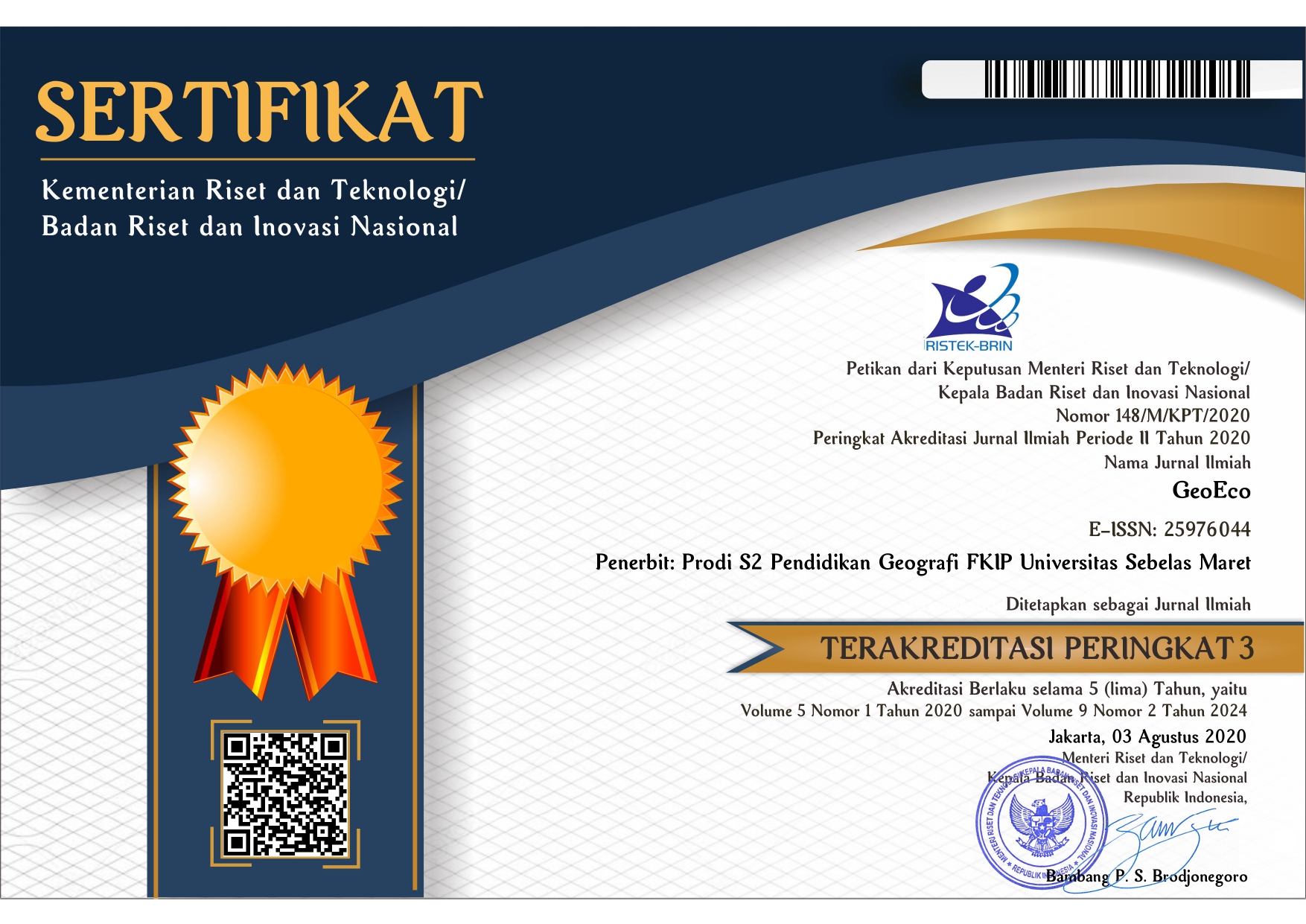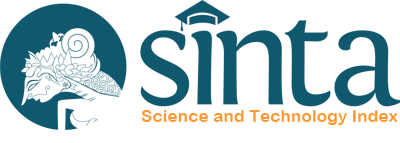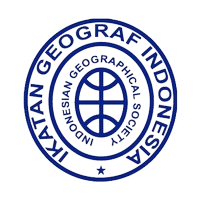STRATEGIES IN IMPROVING STUDENTS' CREATIVE THINKING SKILLS AND GEOGRAPHICAL LEARNING OUTCOMES IN 21ST CENTURY
Abstract
The development of the 21st century is marked by the use of advances in information and communication technology. Its application in the field of education requires students to be able to fulfill various skills. Creative thinking skills are important in the learning process because it is one of the higher-order thinking skills needed to face future challenges. This research was conducted to test the effectiveness of improving creative thinking skills and testing the effectiveness of improving student learning outcomes in social studies learning material on the physical condition of the Indonesian region at Junior High School. The method used in this research is Classroom Action Research (CAR) through cycle stages. This method is used to find out the best practices to achieve the learning objectives. The subjects of this study were 20 students of class VII Junior High School. Data analysis used the calculation of the creative thinking observation scale followed by an analysis of the percentage of students’ complete learning outcomes. The results show that students’ creative thinking skills increased to a very high category in cycle III. Analysis of the percentage of mastery learning outcomes reaching 90% with the average student score of 74,8 in cycle III.
Keywords
Full Text:
PDFReferences
Argaw, A. S., Haile, B. B., Ayalew, B. T., & Kuma, S. G. (2017). The effect of problem based learning (PBL) instruction on students’ motivation and problem solving skills of physics. Eurasia Journal of Mathematics, Science and Technology Education, 13(3), 857–871. https://doi.org/10.12973/eurasia.2017.00647a Ariyana, Y. (2018). Buku Pegangan Pembelajaran Berorientasi pada Ketrampilan Berpikir Tingkat Tinggi. Dirjen GTK Kemendikbud. Balım, A. G. (2009). The Effects of Discovery Learning on Students ’ Success and Inquiry Learning Skills. Eurasian Journal of Educational Research, 35(35), 1–20. Eragamreddy, N. (2013). Teaching Creative Thinking Skills. International Journal of English Language & Translation Studies, 1(2), 124–145. https://doi.org/10.1177/0887302x15569010 Griffin, P., & Care, E. (2015). Assessment and Teaching of 21st Century Skills. In Assessment and Teaching of 21st Century Skills. Spinger. https://doi.org/10.1007/978-94-017-9395-7_1 Hanafi. (2016). The Effect of Discovery Learning Method Application on Increasing Students’ Listening Outcome and Social Attitude. Dinamika Ilmu, 16(2), 291–306. https://doi.org/10.21093/di.v16i2.552 Harris, R. (2002). Creative Thinking Techniques. Virtuak Salt, 1–18. w w w . v i r t u a l s a l t . c o m Kemmis, S., & Taggart, R. (1992). The Action Research Planner. Deakin University. Milewski, I. (1999). The What, Why and How of Classroom Action Reseacrh. 1(10), 9–39. https://www.researchgate.net/publication/326083037%0AClassroom Patrianingsih, E. A., B, N., & Kaseng, E. S. (2017). Pengaruh Model Pembelajaran Discovery Learning Terhadap Pemahaman Konsep Biologi dan Sikap Ilmiah Peserta Didik SMA Negeri 3 Takalar. UNM Journal Of Biological Education, 1(1). https://ojs.unm.ac.id/UJBE/article/view/5382 Purrohman, S. P. (2018). Classroom Action Research Alternative Research Activity for Teachers. Research Gate, June, 1–9. https://www.researchgate.net/publication/326083037%0AClassroom Rahman, M. H. (2017). Using Discovery Learning to Encourage Creative Thinking. International Journal of Social Sciences & Educational Studies, 4(2). https://doi.org/10.23918/ijsses.v4i2sip98 Rotherham, A. J., & Willingham, D. T. (2010). 21st Century Skills. American Educator, 17–20. https://doi.org/10.4018/978-1-4666-9823-9.les2 Sahin, M. C. (2009). Instructional design principles for 21st century learning skills. Procedia - Social and Behavioral Sciences, 1(1), 1464–1468. https://doi.org/10.1016/j.sbspro.2009.01.258 Saifiana, A. A. P., & Purnomo, T. (2017). Pengembangan Perangkat Pembelajaran IPA Model Project Based Learning (PjBL) Untuk Meningkatkan Hasil Belajar Siswa Kelas VII SMPN 2 Sidoarjo. Pensa: Jurnal Pendidikan Sains, 5(02), 92–98. Salpeter, J. (2009). 21st Century Skills: Will Our Students Be Prepared? Technology and Learning, 1–7. http://www.techlearning.com/article/13832%0ALearning Sanjaya, W. (2016). Media Komunikasi Pembelajaran. Kharisma Putra Utama. Silva, E. (2015). Measuring Skills for 21st Century Learning. In Phi Delta Kappan. Sugiyono. (2013). METODE PENELITIAN PENDIDIKAN Pendekatan Kuantitatif, Kualitatif, dan R&D (17th ed.). Alfabeta. Thobroni, M. (2016). Belajar dan Pembelajaran. Ar-Ruzz Media. Vonglao, P. (2017). Application of fuzzy logic to improve the Likert scale to measure latent variables. Kasetsart Journal of Social Sciences, 38(3), 337–344. https://doi.org/10.1016/j.kjss.2017.01.002 Wechsler, S. (2010). Validity of the Torrance Tests of Creative Thinking to the Brazilian Culture. Creativity Research Journal, 18(1), 15–25. https://doi.org/10.1207/s15326934crj1801 Widyawardana, A., Tanjung, A., & Bachri, S. (2021). The Innovation of Teaching Materials Based on Local Wisdom for Disaster Mitigation Subject. GeoEco, 7(1), 23–37. www.ascd.org Winter, R. (1996). New Directions in Action Research. The Palmer Press.
Refbacks
- There are currently no refbacks.












.png)

